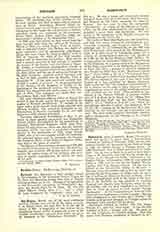

Bar-Kepha, MOSES, one of the most celebrated Jacobite bishops and writers of the ninth century, b. at Balad, about the year 813; d, at the age of ninety, in 903. A biography of him, written by an anonymous Syriac writer, is preserved in one of the Vatican manuscripts, extracts from which are given by Assemani in his “Bibliotheca Orientalis” (II,218 sq.). He was a monk and afterwards became bishop of three cities, Beth-Ramman, Beth-Kionaya, and Mossoul on the Tigris, assuming the name of Severus. For ten years he was the patriarchal “Periodeutes”, or visitor, of the Diocese of Tagrit, where, by his wise administration and learning, he acquired a great fame and reputation. He was buried in the monastery of St. Sergius, situated on the Tigris, near his native city.
The works of Moses Bar-Kepha are very numerous, and deal with many theological, philosophical, controversial, exegetical, and liturgical subjects. The principal are: (I) A Commentary on the Old and New Testaments, often quoted by Bar Hebrmus, and most of it still extant in manuscript form; (2) a treatise on predestination and free will, preserved in a MS. in the British Museum (Add. 14,731); (3) a commentary on Aristotle‘s “Dialectics”, mentioned by Bar Hebraeus; (4) a commentary on the Hexameron in five books, preserved in the Bibliotheque Nationale at Paris (Syr. 241), a passage of which is translated into French by Abbe Nau in his “Bardesane l’astrologue” (Paris, 1899), p. 59; (5) a “Tractatus de Paradiso”, in three parts, dedicated to his friend Ignatius. [The Syriac original of this work is lost, but a Latin version of it was published by Masius (Antwerp, 1569) under the title “De Paradiso Commentarius”.] (6) A treatise on the soul, in forty chapters, with a supplementary essay on the utility of offering prayers and sacrifices for the dead. [This treatise is preserved in the Vatican Library; a German translation of it is given by O. Braun in his “Moses Bar-Kepha and rein Buch von der Seele” (Freiburg, 1891).] (7) A “Tractatus de sectis”, or, “Liber dispputationum adversus haereses” (see Assemani, B. O. II, 57); (8) a treatise on the Sacraments; (9) a commentary on the Liturgy; (10) an ecclesiastical history. His other works comprise discourses, homilies, and a commentary on the writings of St. Gregory Nazianzen.
GABRIEL OUSSANI

